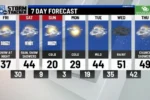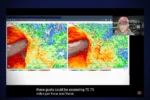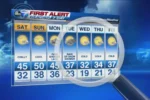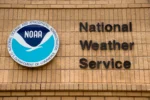Get ready, Western New York! The National Weather Service has issued an important winter weather advisory that will affect your area starting Wednesday. This means we might see a mix of snow, sleet, and even some ice, which can make roads very slippery and traveling dangerous. In cities like Buffalo and Niagara Falls, you should be prepared for possible power outages due to strong winds. So, bundle up and stay safe as we dive into the details of this winter storm and how it will impact our communities!
| Region | Advisory Duration | Expected Precipitation | Snow Accumulation | Ice Accumulation | Wind Gusts | Impact on Travel |
|---|---|---|---|---|---|---|
| Niagara, Orleans, Northern Erie, Genesee Counties | Until 4 a.m. Thursday | Mixed precipitation | 1 inch or less (up to 3 inches in Niagara and Orleans) | Up to 0.1 inch in Niagara and Orleans | N/A | Hazardous travel conditions due to slippery roads and limited visibility. |
| Wyoming and Allegany Counties | Same as above | N/A | N/A | N/A | 40 to 50 mph gusts | Potential power outages and hazardous conditions. |
| Cattaraugus, Chautauqua, Southern Erie Counties | Until 7 a.m. Friday | Mixed precipitation changing to snow | 1 inch or less (4 to 7 inches expected on Thursday) | Around 0.1 inch | 40 to 50 mph gusts | Hazardous conditions affecting evening and morning commutes. |
Understanding Winter Weather Advisories
A winter weather advisory is a notice from the National Weather Service that tells people to be careful because of bad weather. In Western New York, the advisory means that snow, sleet, and ice are expected, which can make roads slippery. It’s important for everyone to pay attention to these advisories so they can stay safe. If you have to travel, you should be ready for tough conditions and consider staying home if possible.
When a winter weather advisory is issued, it helps people prepare for the worst. For example, knowing that there will be mixed precipitation like snow and freezing rain can encourage drivers to plan ahead. They might leave earlier to avoid heavy traffic or might choose to work from home. The advisory also reminds people to check on their neighbors and ensure they have what they need in case of power outages or other problems.
Preparing for Hazardous Travel Conditions
When winter weather hits, it’s important to prepare for hazardous travel conditions. This means checking the weather before you leave and making sure your vehicle is ready. Drivers should keep an emergency kit in their car, including blankets, snacks, and a flashlight, in case they get stuck. Staying informed about road closures and accidents can also help keep everyone safe while traveling.
Additionally, if you must travel during a winter storm, it’s wise to drive slowly and give yourself extra time to reach your destination. Visibility can be low during snowstorms, and roads can become very slippery. It’s safer to stay off the roads if conditions are severe, but if you do go out, always buckle up and keep a safe distance from other vehicles.
What to Expect in Different Counties
Different counties in Western New York are experiencing various weather conditions due to the winter weather advisory. For instance, Niagara and Orleans Counties are expected to get some snow and ice. This means that people living there should prepare for slick roads and possibly limited visibility. It’s a good idea for families in these areas to plan indoor activities while the weather is bad.
Meanwhile, in counties like Wyoming and Allegany, strong winds could cause more problems, such as fallen branches or power outages. People should make sure they have candles and batteries on hand in case the power goes out. Each area has its own challenges during a winter storm, so staying informed and preparing accordingly can help everyone stay safe.
Understanding the Winter Weather Advisory
The National Weather Service (NWS) Buffalo has issued a winter weather advisory, indicating a significant weather event is on the horizon for the region. This advisory serves as a crucial alert for residents to prepare for challenging conditions, including mixed precipitation and potential ice accumulations. It’s essential to stay informed through local news and weather updates to understand the specific impacts on your area, especially for those in the affected counties.
With the advisory in place, it is vital for residents to assess the risks associated with winter weather. Mixed precipitation can lead to slippery roads and reduced visibility, making travel hazardous. Understanding the nuances of the advisory helps individuals plan their activities accordingly, whether that means rescheduling travel plans or ensuring that necessary supplies are stocked at home.
Anticipating Impact on Travel Conditions
As the winter weather advisory takes effect, travel conditions are expected to deteriorate significantly. The forecast predicts periods of snow, sleet, and freezing rain, which can create treacherous roadways. Drivers should exercise caution, allowing for extra travel time and reducing speed, especially during the Wednesday evening and Thursday morning commutes when conditions may be at their worst.
In addition to slippery roads, gusty winds could exacerbate the situation, potentially leading to isolated power outages. Travelers should stay updated on road conditions and consider alternative routes if necessary. It’s also advisable to have an emergency kit in vehicles, including blankets, food, and water, should you become stranded.
Preparation is key during winter weather events, so being proactive can make a significant difference in ensuring safety.
Regional Weather Variations and Precautions
Different regions within Western New York will experience varying weather impacts due to the winter weather advisory. For instance, Niagara and Orleans Counties may see higher snow accumulations compared to other areas, influencing local travel and safety measures. Residents in these counties should be particularly vigilant and adapt their plans based on local forecasts and recommendations from the NWS.
Additionally, in counties like Wyoming and Allegany, strong winds could pose unique challenges, especially for those in higher elevations. Local authorities may issue specific advisories relating to wind-related hazards, and it’s wise to stay informed about potential power outages and other weather-related disruptions.
Safety Tips for Severe Winter Weather
With severe winter weather on the way, safety should be a top priority for residents. It’s essential to prepare your home and vehicle for the impending conditions by ensuring that your heating system is functional, and your vehicle is winter-ready with good tires and emergency supplies. Keep a battery-powered radio handy to receive updates in case of power outages.
Moreover, it’s advisable to limit travel during the worst weather conditions if possible. If travel is necessary, inform someone of your itinerary and estimated arrival time. Carrying a winter emergency kit in your vehicle can be life-saving, containing essentials like food, water, first-aid supplies, and warm clothing.
Frequently Asked Questions
What is a winter weather advisory and why do we need it?
A **winter weather advisory** is a warning from weather experts about bad weather. It helps us prepare for things like **snow** or **ice** that can make traveling dangerous.
What kind of weather can we expect during the advisory?
During the advisory, we might see **snow**, **sleet**, or **freezing rain**. This mix can make roads slippery and hard to drive on, so we need to be careful!
How can bad weather affect our daily routines?
Bad weather can make **commuting** to school or work difficult. Slippery roads can lead to **accidents**, and strong winds might cause **power outages**.
What should I do to stay safe during a winter storm?
To stay safe, you should:
– **Stay indoors** if possible.
– **Avoid driving** unless necessary.
– Have an **emergency kit** ready in case of power cuts.
Why do strong winds during a winter storm matter?
Strong winds can make it feel even colder and might cause **power outages** by knocking down **trees** or **power lines**. This can leave homes without electricity.
What areas are most affected by the winter weather advisory?
The cities most affected include **Niagara Falls**, **Buffalo**, and **Jamestown**. These places may see a lot of **snow** and **ice** during the advisory.
How much snow and ice are expected in our area?
Most areas will get about **1 inch of snow** or less, but places like **Niagara** and **Orleans** Counties could see up to **3 inches** and a little bit of **ice**.
Summary
The National Weather Service Buffalo has issued a winter weather advisory for all of Western New York, effective from Wednesday through Thursday morning. Mixed precipitation, including snow, sleet, and freezing rain, may create hazardous travel conditions due to slippery roads and low visibility. Specific areas, such as Niagara and Orleans counties, expect up to three inches of snow and ice accumulations. Additionally, high winds of 40 to 50 mph could lead to power outages. The advisory emphasizes the potential impact on Wednesday evening and Thursday morning commutes, urging caution for travelers in the affected regions.







